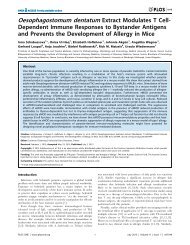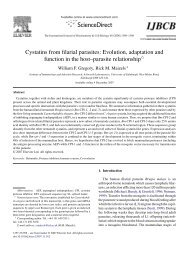Experimental Parasitology - Rick Maizels' Group - University of ...
Experimental Parasitology - Rick Maizels' Group - University of ...
Experimental Parasitology - Rick Maizels' Group - University of ...
You also want an ePaper? Increase the reach of your titles
YUMPU automatically turns print PDFs into web optimized ePapers that Google loves.
Antibody Targets<br />
The molecular identification <strong>of</strong> individual HES components has now provided the opportunity<br />
to define the immunogenic components <strong>of</strong> H. polygyrus. Questions <strong>of</strong> antibody specificity are<br />
difficult to judge from the earlier studies, which relied on complex antigen mixtures, and did<br />
not extend to the use <strong>of</strong> monoclonal antibodies. More recently, we have analyzed the serum<br />
antibody pr<strong>of</strong>ile <strong>of</strong> infected mice, and found that reactivity is predominantly to HES, rather<br />
than somatic extract (Hewitson, et al., 2011a). From this study, and by analysing monoclonal<br />
antibodies derived from infected mice, we showed that the major antigens in both primary and<br />
secondary infection are members <strong>of</strong> the VAL family, and the epitopes are both glycan and<br />
peptide in nature, which we have defined as follows (Figure 4).<br />
Glycan A is an immunodominant O-linked epitope carried on VAL-1, -2 and -5, which stimulates<br />
an early IgM response that does not class switch. Monoclonal antibodies to glycan A bind to the<br />
adult worm surface but do not react strongly with somatic components. In contrast, glycan B is<br />
present on diffusely migrating non-protein staining components <strong>of</strong> 60-70 kDa (Ag65), and <strong>of</strong><br />
very high mol.wt (Ag-HM). Monoclonal antibodies to the glycan B epitope bind adult somatic<br />
tissues rather than the cuticle, and the response class switches to IgG1 and IgA in vivo. HM-65<br />
bears phosphorylcholine (PC), but the glycan B epitope itself is not PC (Hewitson, et al., 2011a).<br />
Class-switched IgG1 antibodies also develop to the polypeptide backbone <strong>of</strong> VAL proteins,<br />
including additional members VAL-4 and VAL-7. While vaccination with HES can induce<br />
complete immunity to challenge infection, it was not possible to confer passive protection with<br />
monoclonal antibodies against either the glycan epitopes, or VAL-1, -2 and -4 proteins. Thus, it<br />
appears that the murine immune response generates nonprotective antibodies, perhaps due to<br />
the dominance <strong>of</strong> a small subset <strong>of</strong> antigenic epitopes (Hewitson, et al., 2011a). One possibility<br />
is that the glycan determinants act as decoy specificities, stimulating the primary immune<br />
response to produce only non-protective antibodies.<br />
Another unanswered question is the mechanism <strong>of</strong> action <strong>of</strong> protective antibodies: the effect<br />
<strong>of</strong> passive immunisation requires early serum transfer, implying a tissue phase target<br />
(compromising the growth or fitness <strong>of</strong> larval parasites for example), but the ability to reduce<br />
adult worm fecundity could also indicate activity against parasites in the lumen. If antibodies<br />
are effective in the latter setting, it may then be significant that high levels <strong>of</strong> intestinal IgG1<br />
are observed in mucosal washings <strong>of</strong> infected, but not naïve, mice ((Ben-Smith, et al., 1999)<br />
and Filbey, K.J. unpublished). It remains to be established whether there is a specific transport<br />
Maizels et al Hydra Special Issue Page 17





